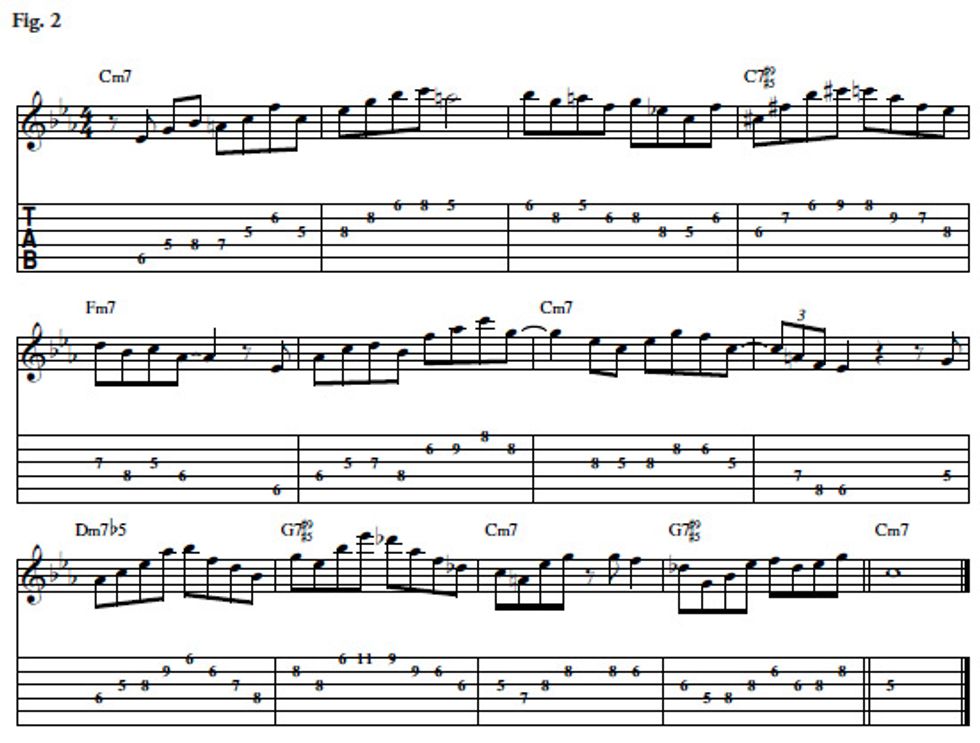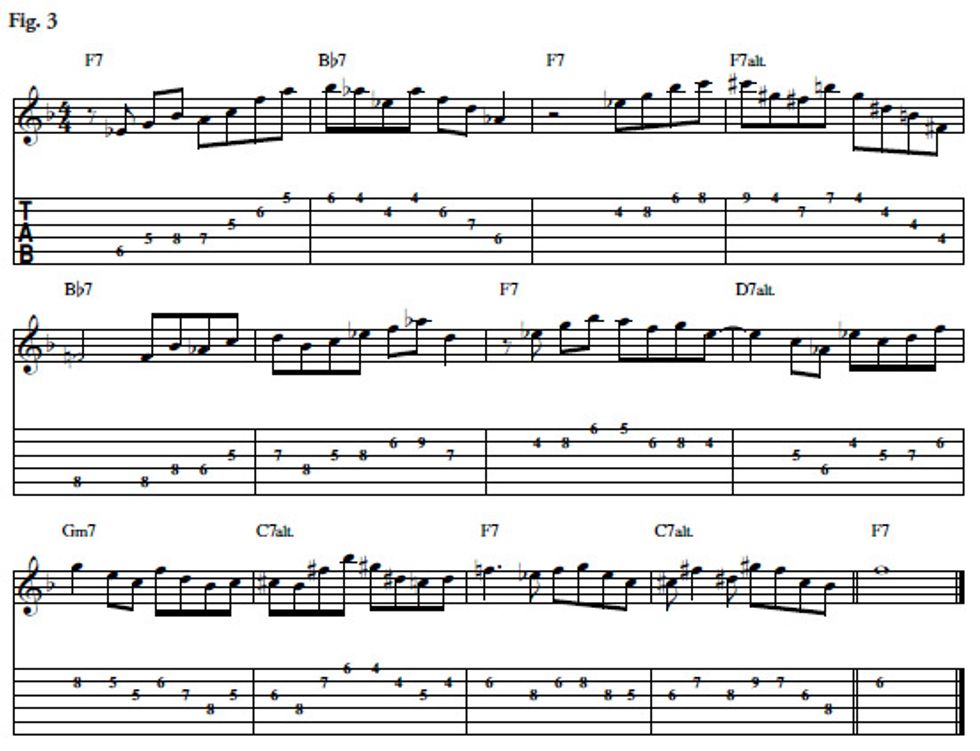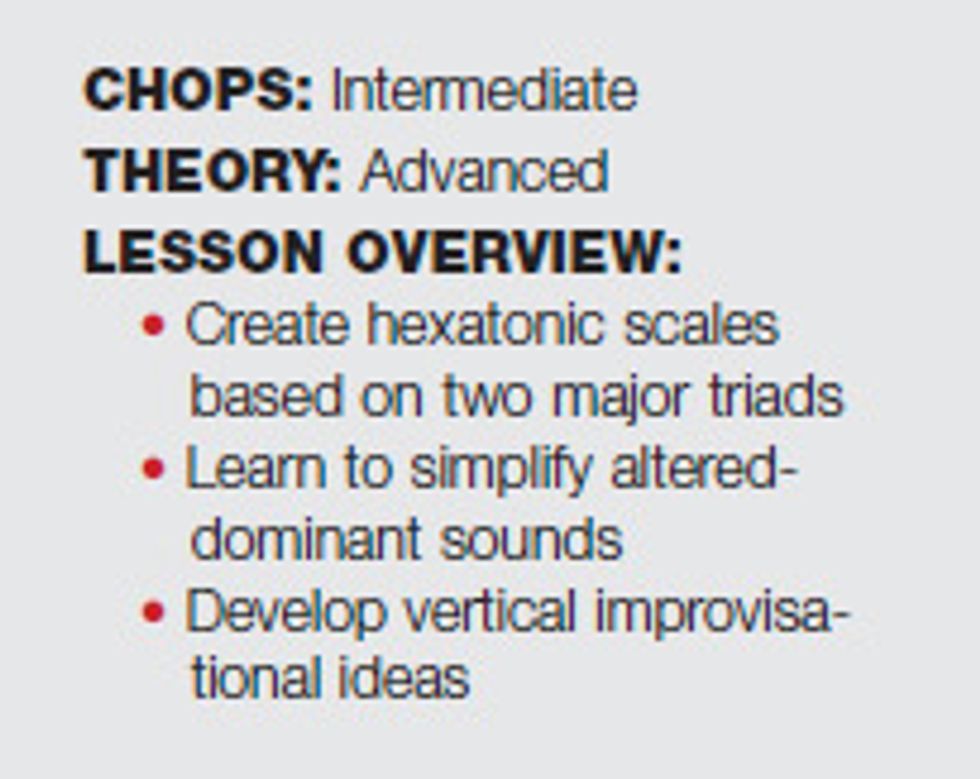In this lesson, I’m going to focus on some
of the interesting sounds you can get from
hexatonic scales. A hexatonic scale—which can
also be thought of as a combination of two
triads—is a six-note scale. To keep things simple,
we are going to investigate how to combine
major triads a whole-step apart, but there
are a number of other commonly used triad
pairs. If you are interested in learning more
about triad pairs, I can recommend Hexatonics
by Jerry Bergonzi (Advance Music Press).
Fig. 1 shows an example of a hexatonic scale constructed from C and D major triads. There are a few ways you can conceptualize these scales. The first is to view it from the lower triad. For instance, in Fig. 1 you can see this as a C Lydian scale without the 7th scale degree. The other way of looking at it would be from the upper triad—a D Mixolydian scale without the 6th. I hear this scale as somewhere between a scalar sound and an arpeggio, although it doesn’t have as much of an arpeggio sound as a pentatonic scale. It’s an angular, edgy sound I associate with musicians such as trumpeter Woody Shaw and pianist McCoy Tyner. If you check out Kurt Rosenwinkel’s intro to “How Deep is the Ocean” on his wonderful recording Intuit, you can hear how he uses this idea over an altered-dominant chord.
Download or Listen:

Next, we’re going to look at the application of this scale over both a minor and major jazz-blues progression. Fig. 2 is an étude I wrote based on a blues in the key of C minor. Over each chord, we focus on the notes from major triads built on two neighboring scale tones, depending on what type of sound we want. For example, over Cm7, we’ll use the Eb and F major triads, and for Fm7, we’ll use Ab and Bb major triads. On the altered-dominant chords in measure 4, 10, and 12, we use triads built off the b5 and the b6 scale degrees. The same concept works over minor 7b5 chords, as you can see in measure 9.
Download or Listen:

The minor blues in the jazz repertoire has a long history. John Coltrane (“Equinox”), Grant Green (Duke Pearson’s “Minor League”), Joe Henderson (“Granted”), Jim Hall (“Big Blues”), Dizzy Gillespie (“Birks Works”), and many other jazz giants have all written and improvised on a minor blues.
In Fig. 3 you can see how this works over a major (or dominant) blues. Over the dominant chords, we’ll use triads built on the root and b7 of each chord. As you can see, we outline an Eb major triad with the first three notes in the first measure and then move to a first-inversion F major triad. Hear how this creates a big, bright sound?
Download or Listen:

If you like the sound of these scales, pianist McCoy Tyner would be a good choice for transcribing, especially his great recording The Real McCoy.
 Bruce Saunders
Bruce Saunders
Bruce Saunders is an award-winning guitarist, composer, author, and educator. He has recorded, performed, and toured with some of the world’s best jazz musicians, including Jack DeJohnette, Dave Holland, Bill Stewart, and Peter Erskine. Saunders has been a faculty member at the Berklee College of Music since 1992 and has also taught at New York University and The New School, and conducted clinics and concerts in many countries. Visit brucesaunders.com for more information.
Fig. 1 shows an example of a hexatonic scale constructed from C and D major triads. There are a few ways you can conceptualize these scales. The first is to view it from the lower triad. For instance, in Fig. 1 you can see this as a C Lydian scale without the 7th scale degree. The other way of looking at it would be from the upper triad—a D Mixolydian scale without the 6th. I hear this scale as somewhere between a scalar sound and an arpeggio, although it doesn’t have as much of an arpeggio sound as a pentatonic scale. It’s an angular, edgy sound I associate with musicians such as trumpeter Woody Shaw and pianist McCoy Tyner. If you check out Kurt Rosenwinkel’s intro to “How Deep is the Ocean” on his wonderful recording Intuit, you can hear how he uses this idea over an altered-dominant chord.
Download or Listen:

Next, we’re going to look at the application of this scale over both a minor and major jazz-blues progression. Fig. 2 is an étude I wrote based on a blues in the key of C minor. Over each chord, we focus on the notes from major triads built on two neighboring scale tones, depending on what type of sound we want. For example, over Cm7, we’ll use the Eb and F major triads, and for Fm7, we’ll use Ab and Bb major triads. On the altered-dominant chords in measure 4, 10, and 12, we use triads built off the b5 and the b6 scale degrees. The same concept works over minor 7b5 chords, as you can see in measure 9.
Download or Listen:

The minor blues in the jazz repertoire has a long history. John Coltrane (“Equinox”), Grant Green (Duke Pearson’s “Minor League”), Joe Henderson (“Granted”), Jim Hall (“Big Blues”), Dizzy Gillespie (“Birks Works”), and many other jazz giants have all written and improvised on a minor blues.
In Fig. 3 you can see how this works over a major (or dominant) blues. Over the dominant chords, we’ll use triads built on the root and b7 of each chord. As you can see, we outline an Eb major triad with the first three notes in the first measure and then move to a first-inversion F major triad. Hear how this creates a big, bright sound?
Download or Listen:

If you like the sound of these scales, pianist McCoy Tyner would be a good choice for transcribing, especially his great recording The Real McCoy.
 Bruce Saunders
Bruce SaundersBruce Saunders is an award-winning guitarist, composer, author, and educator. He has recorded, performed, and toured with some of the world’s best jazz musicians, including Jack DeJohnette, Dave Holland, Bill Stewart, and Peter Erskine. Saunders has been a faculty member at the Berklee College of Music since 1992 and has also taught at New York University and The New School, and conducted clinics and concerts in many countries. Visit brucesaunders.com for more information.











![Rig Rundown: Russian Circles’ Mike Sullivan [2025]](https://www.premierguitar.com/media-library/youtube.jpg?id=62303631&width=1245&height=700&quality=70&coordinates=0%2C0%2C0%2C0)






